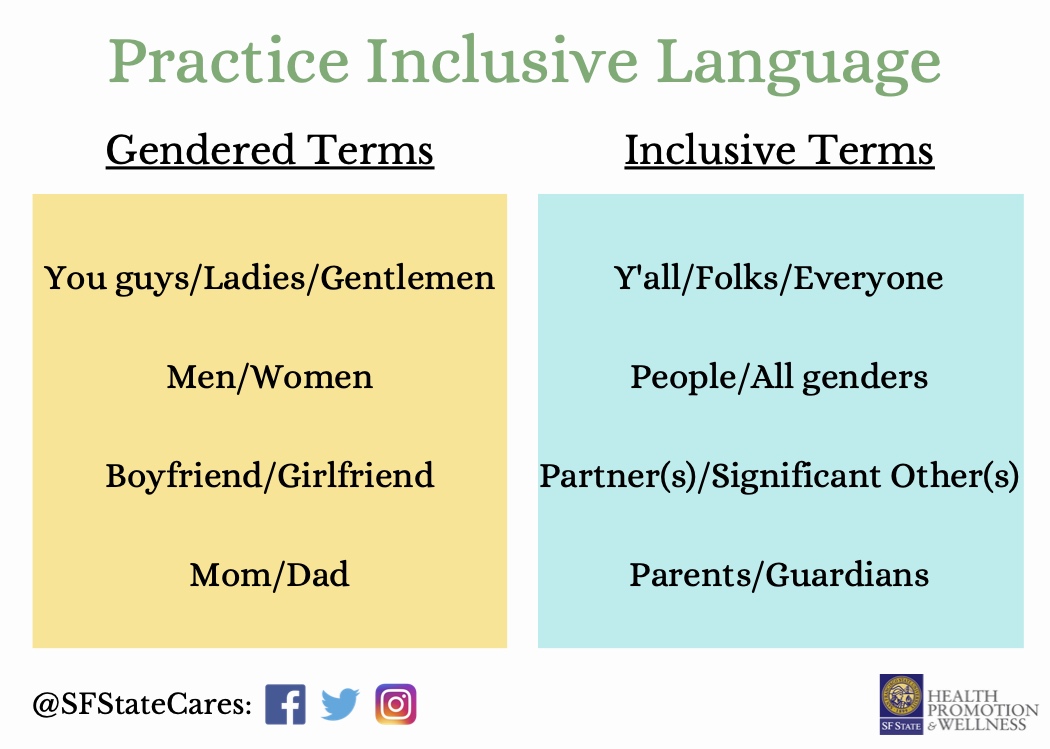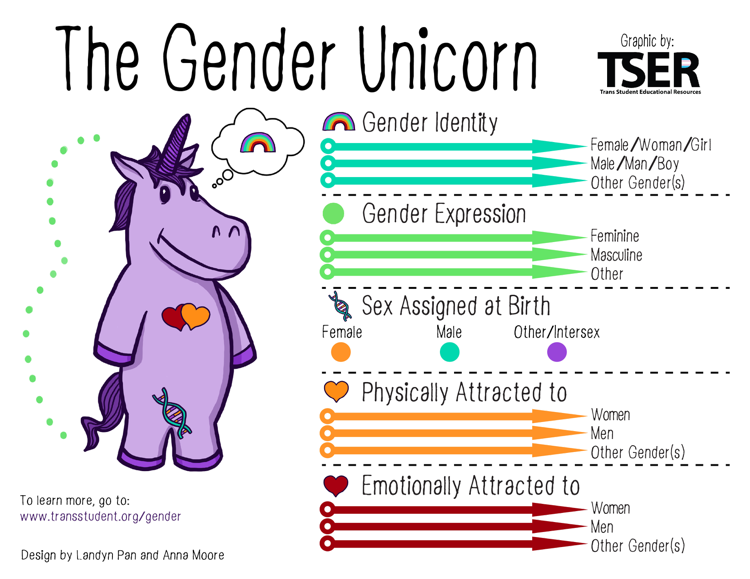Sexuality
Sexuality is an all-encompassing term referring to how people express themselves sexually, which can include their desires, fantasies, behaviors, practices, and relationships.
Sexual Orientation
Sexual orientation refers to a person’s physical, romantic, emotional, aesthetic, and/or other form of attraction to others. People can have multiple orientations, for example, one which describes their romantic attraction and one for sexual attraction.
Identities
People may explore different identities to determine what they feel describes their attraction(s) best. Identities can be a great way for someone to feel seen, find support, and connect to communities. However, not everyone may use a label to describe their identity, and that’s okay!
There are many other identities and terms; to learn more, visit Trans Student Educational Resource (TSER)
Some examples of sexual identities include:
Pansexual: attraction to a person regardless of gender
Demisexual: attraction which follows after an emotional connection has been established
Aromantic: people who don’t seek our or need romantic relationships the way they’re typically portrayed
Gender
Gender Identity: This refers to one’s internal sense of being, whether that’s male, female, neither, both, or other gender(s). Examples include:
Cisgender: someone whose gender identity aligns with their sex assigned at birth
Transgender: someone whose gender identity differs from their sex assigned at birth
Non-binary: someone whose gender identity exists outside the man/woman gender binary
Genderfluid: someone whose gender identity changes or fluctuates along different identities and/or presentations
Inclusive Language
Inclusive language ensures we reach and encompass wider audiences, and acknowledges there are relationship and gender structures different from what we might have previously known. Typically, these phrases would be used for large reaching projects (social media, presentations, meetings, classrooms, etc.).
Here are some examples of alternative, inclusive, options for common gendered terms and phrases:

Pronouns
Pronouns are words we use to substitute nouns in a sentence and/or refer to speaker(s) or subject(s) of a sentence. Pronouns include words like: I, we, our, hers, theirs, etc. These are terms we use every day.
When someone shares their pronouns (she/her; he/him; they/them), it’s to let people know how they’d like to be referred to. Using someone’s correct pronouns demonstrates respect, and this includes using them even when the person isn’t around.
Mistakes happen! How we handle those mistakes is what matters. If you accidentally misgender someone, it’s important to immediately acknowledge the mistake, repeat the phrase/sentence with the correct pronoun, and then move on. It can feel really upsetting and shameful, in a way, when we misgender someone, However, if you pull attention to the mistake, you’re putting the attention on yourself and have moved away from the person(s) you’ve hurt with your language.
Gender Identity
One’s internal sense of being male, female, neither of these, both, or another gender(s). Everyone has a gender identity, including you. For transgender people, their sex assigned at birth and their own internal sense of gender identity are not the same. Female, woman, and girl and male, man, and boy are also NOT necessarily linked to each other but are just six common gender identities.
Gender Expression
How someone expresses themselves through clothing, hairstyle, mannerisms, etc. Expression may not reflect someone’s gender identity because they may not be out in certain spaces, are exploring different types of expression, or don’t associate identity with what they wear.

The Gender Unicorn is an educational tool which provides a little overview of how gender identities, expressions, and physical and romantic attractions exist on spectrums. Feel free to review the unicorn and think about where you may fall on these different spectrums.
LGBTQ Definitions: A list of terms & definitions regarding gender identity, gender expression, sexuality, and more.
Sex Assigned at Birth
The assignment and classification of people as male, female, intersex, or another sex based on a combination of anatomy, hormones, chromosomes. It is important we don’t simply use “sex” because of the vagueness of the definition of sex and its place in transphobia. Chromosomes are frequently used to determine sex from prenatal karyotyping (although not as often as genitalia). Chromosomes do not determine genitalia.
Sexually Attracted To Sexual Orientation
It is important to note that sexual and romantic/emotional attraction can be from a variety of factors including but not limited to gender identity, gender expression/presentation, and sex assigned at birth.
Romantically/Emotionally Attracted To
Romantic/emotional orientation. It is important to note that sexual and romantic/emotional attraction can be from a variety of factors including but not limited to gender identity, gender expression/presentation, and sex assigned at birth.